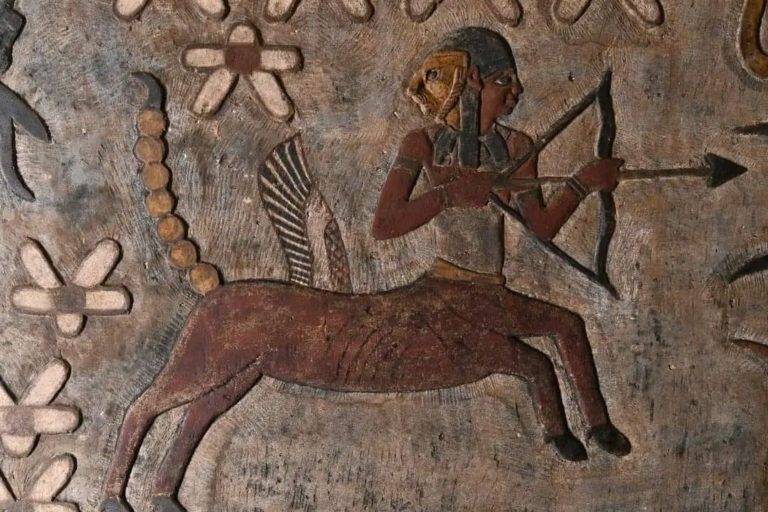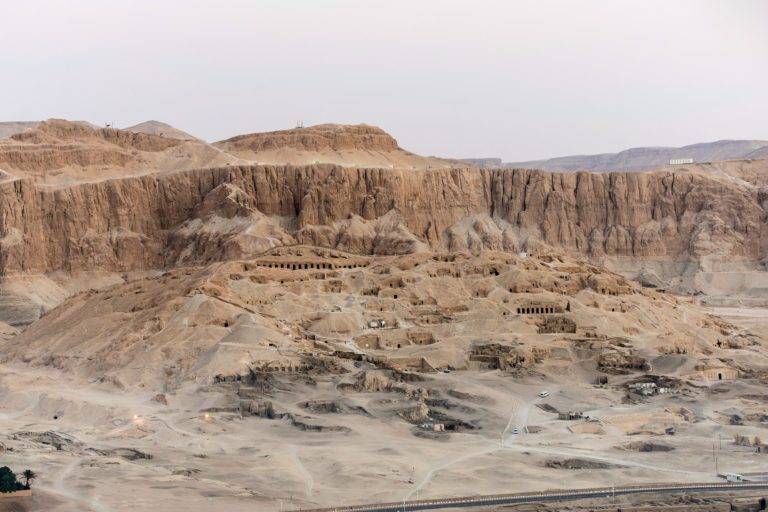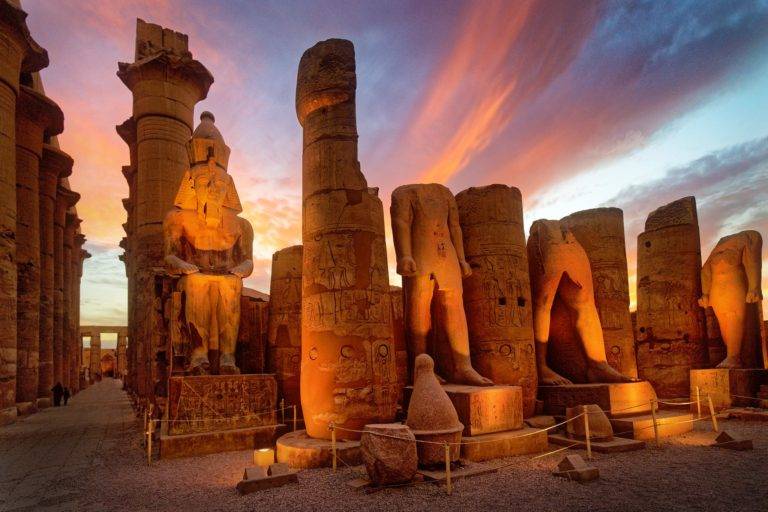Malkata Palace
Palace of Amenhotep III
The royal ceremonial and palace complex at the southern most point of the chain of royal burial temples on the west bank of Thebes is known by its current Arabic name, Malkata. Around the 29th or 30th year of Amenhotep III’s (18th Dynasty) reign, the location was established for the king’s first heb-sed feast. A symbolic act of creation, the founding of the new royal town represented the rebirth of both the king and royal power. The main palace, constructed of mudbrick and decorated with vibrant murals on the walls, floors, and ceilings, is at the heart of the property. At least three smaller palaces for various royal family members surrounded the main palace.

A temple dedicated to the deity Amen is situated at a right angle to the main palace. In terms of architectural features like confined inner rooms, a sequence of colonnaded courts arranged along a single axis, and a substantial enclosure wall enclosing the complex, the king’s home and the god’s house were identical. The villas of the royal officials and other nobility are arranged around the royal complex, along with more modest buildings that operate as the residences and workshops of the palace bureaucrats and craftsmen. Southwest of the main palace, large earth mounds delineate the Birket Habu, a massive artificial basin shaped like a T and once spanning 1.5 km2.

Despite its potential use as a working harbor, the basin’s huge size suggests ceremonial significance. In 1888, Georges Daressy—who was conducting exploratory work while employed at adjacent Medinet Habu—identified Malkata as the location of Amenhotep III’s palace. Under the direction of the American Robb de Peyster Tytus, Percy E. Newberry started conducting systematic excavations in 1900. The Egyptian Expedition of the Metropolitan Museum of Art conducted sporadic excavations at the site between 1910 and 1921.

A Japanese team from Waseda University in Tokyo conducted research on Malkata in the 1970s and discovered an odd ceremonial kiosk or desert altar. The mummified fish that were interred there in the late Roman or Coptic periods are the reason for the site’s current moniker, Kom el-Samak (Hill of Fish). On the other hand, the underlying building was constructed and refurbished in honor of Amenhotep III’s heb-seds. It consists of a platform with a stairway to the north and a ramp to the south housing a kiosk.

Around the 29th or 30th year of Amenhotep III's (18th Dynasty) reign, the location was established for the king's first heb-sed feast.
Luxor Tours & Activities
Looking to save some costs on your travel? Why not join a shared group tour to explore Luxor, Egypt? Here are some activities you might be interested in:
The thirty stairs were painted with images of shackled criminals and bows alternately. The Japanese expedition started working at the Malkata palace in the 1980s, putting special emphasis on studying the mural paintings. The numerous colorful painting pieces aid in denoting the various purposes of the rooms within the Malkata palace. Daressy discovered a tiny audience hall with a painted pavement depicting a scene of ducks, birds, and fish on a papyrus wetland. The chamber’s ceiling was adorned with yellow spirals interspersed with blue and red rosettes. Similar to the ones at Kom el-Samak, chained prisoners and bows adorned the steps of the royal base.

The monarch would “trample” on Egypt’s adversaries in symbolism when he ascended the kiosk or throne. The palace’s main central hall still has sixteen limestone column bases that once held two rows of wooden columns. A picture of the monarch enthroned was painted on the south wall of the hall, possibly representing the scene in the throne chamber beyond; no information about decorations from the throne room itself has surfaced. Even the parts of the palace that were not intended for public viewing were ornately furnished. Rosettes, bulls’ heads, and spirals were painted on panels that adorned the “king’s bedchamber.”

A pattern of vultures with their wings outstretched was painted on the ceiling. The royal suite was finished with a bedroom, a bathroom, robing rooms, retiring rooms, and private dining halls. The ladies of the royal harem are believed to have eight smaller suites, which include an antechamber, a bedroom, a bathroom, and a hall with two columns and an elevated dais against one wall. They have painted grape arbors as decorations, and flying birds and ducks adorn the ceilings. Storerooms, courts, work rooms, royal official apartments, offices, and kitchens were among the other areas of the palace. There were even murals in the storage magazines, pictures of plump cows, levitating calves, and stands piled high with food.

In addition to a Mycenaean sherd found at the site, motifs like the spiral and the “flying gallop” seen in the paintings of Malkata suggest a possible link to the Aegean region. From his funeral temple at Kom el-Hetan, which is located about 5 km southwest of Kom el-Abd, Amenhotep III established a new royal zone at Malkata on the southern portion of the west bank of Thebes. Divergent views exist on the purpose of this imposing royal structure: some believe it was mostly ceremonial (Kemp), while others believe it was designed to serve as an urban administrative hub (O’Connor). The Kom el-Samak building and the entire complex were reconstructed in a new alignment sometime after the palace and its enclosing wall were first built.

The several Heb-sed festivities (in years 34, 37, and 30, as well as others) conducted at the location are often linked to the various reconstruction stages. Malkata has yielded a plethora of minor findings, such as numerous inscriptions on jar labels, sealings, glass, and porcelain, together with beautifully designed (blue-painted) pottery. They couldn’t verify that either Akhenaten or Tutankhamun lived in Malkata, but they could show that the palace was occupied throughout Horemheb’s rule. Akhenaten’s construction of a new city at Tell el-Amarna was inspired by the expansive linear layout of Malkata, which has palaces, temples, villas, and other structures arranged along the edge of the agriculture at a spot that had not yet been inhabited.
Unfortunately, only the bottom portions of a few paintings and the base of the mud brick walls remain at this monument, which has now severely decayed over time. Although there isn’t much to attract attention, except for the most passionate Egyptology enthusiasts, there are occasional bursts of color and broken tile that demonstrate how exquisitely the palace was decorated. As a result, it is not a popular tourist destination. However, fragments of the decorations are showcased at the Cairo Museum, and you can request special permission to visit the site.
F.A.Q
On the west bank of the Nile, across from the contemporary city of Luxor, are the remnants of the festival city of Malqata.
The buildings were made of stone, mud brick, and magnificently painted images of gods, animals, and the pharaoh himself adorned the walls. One of the most remarkable features of the main palace is the audience hall, often known as the Great Hall of Audience.
Malkata
Malkata, also known as Malqata in Arabic (الملقطة), literally meaning “the place where things are picked up,” is the location of an ancient Egyptian palace complex constructed in the New Kingdom by Amenhotep III, king of the 18th Dynasty.
Few palaces have been excavated, nevertheless, despite their significance. The best preserved of them is the Amenhotep III palace complex at Malqata, located in southwest Thebes. Known as Amenhotep the Magnificent, he ruled Egypt from 1386 to 1353 BCE and is regarded as its greatest constructor.






